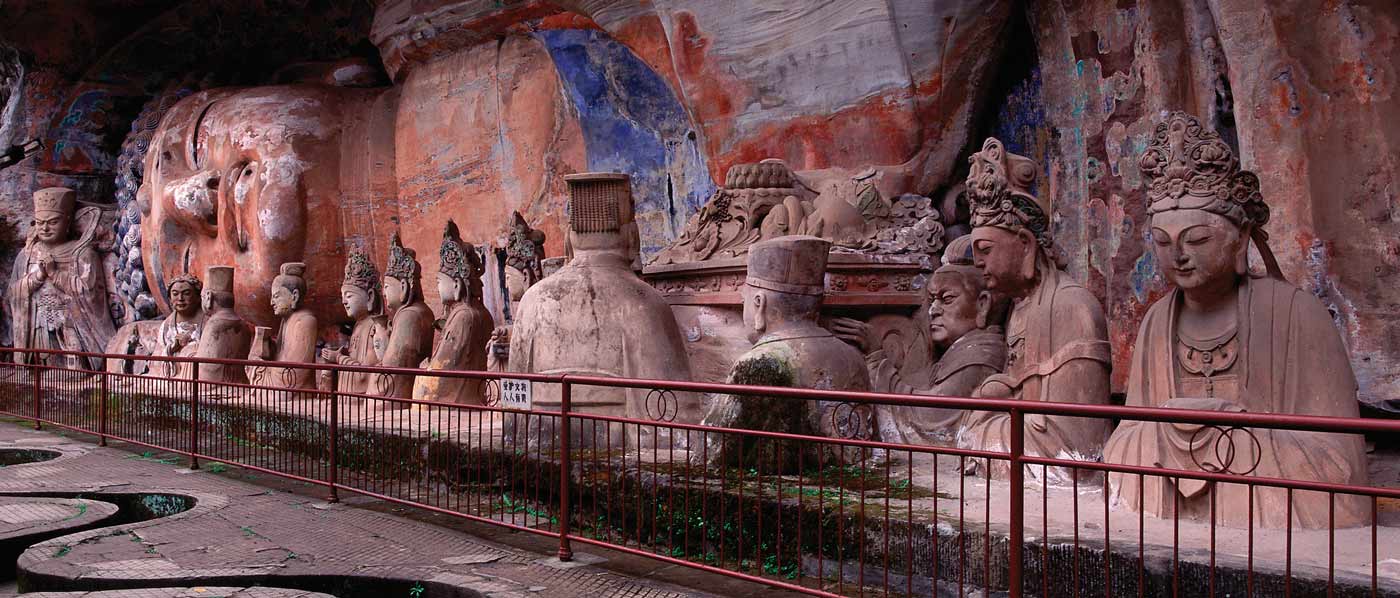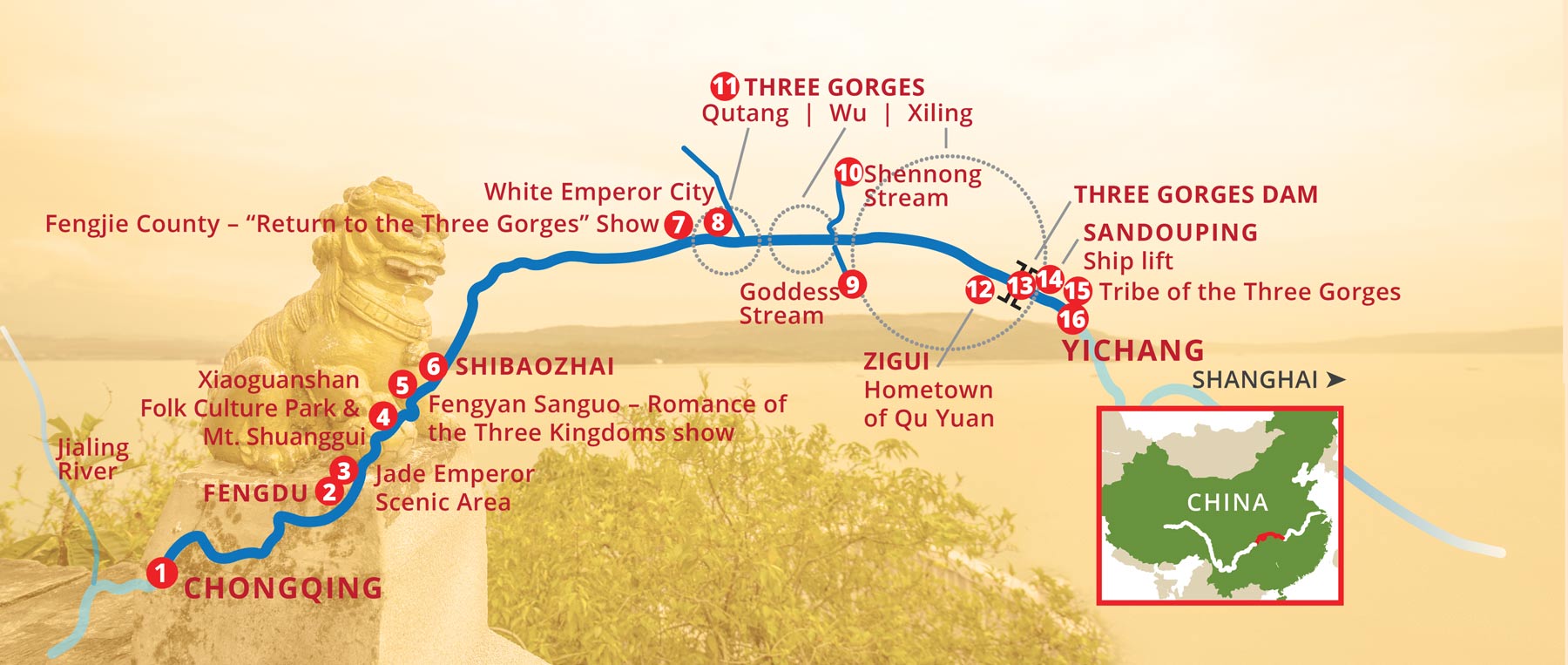- 1Chongqing ›
- 2Fengdu ›
- 3Jade Emperor Scenic Area ›
- 4Xiaoguanshan Park & Mt. Shuanggui ›
- 5Romance of The Three Kingdoms ›
- 6Shibaozhai ›
- 7Return To The Three Gorges Show ›
- 8White Emperor City ›
- 9Goddess Stream ›
- 10Shennong Stream ›
- 11Three Gorges ›
- 12Zigui, Hometown of Qu Yuan ›
- 13Three Gorges Dam ›
- 14Ship Lift, Sandouping ›
- 15Tribe of The Three Gorges ›
- 16Yichang ›
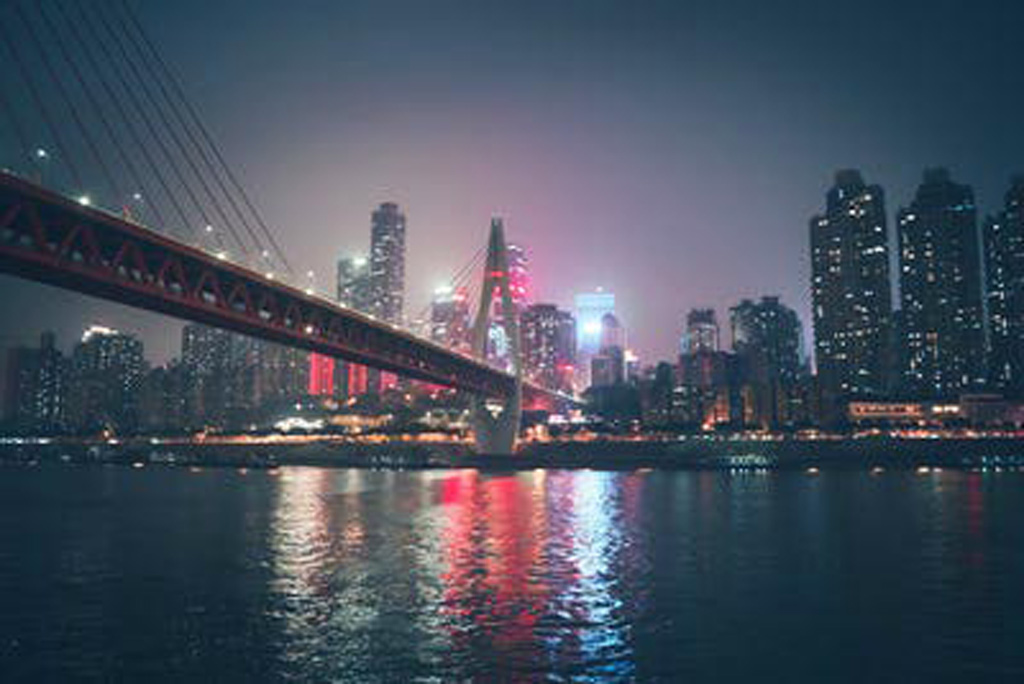
Chongqing: "The Mountain City"
Picturesque Chongqing is a growing megalopolis that clings to steep cliffs at the confluence of the Yangtze and Jialing Rivers. A trading capital for centuries, Chongqing was established in 1997 by China as the nation’s fourth directly-administered municipality. Chongqing now administers an area of 82,365 square kilometers, with a population exceeding 30 million. It is an important hub of communications, industry and transportation in southwest China.
Chongqing’s origin dates back over 3,000 years. It was the capital of the ancient Ba Kingdom before it fell to the Qin state in 316 B.C. More recently, Chongqing was China’s war- time capital and headquarters of Chiang Kai-shek’s Nationalist government in World War II. The island over which the Yangtze River Bridge is now built served as an airstrip for “The Flying Tigers”. After the war, Chiang Kai-Shek and Mao Zedong participated in the “Chongqing Talks”, seeking unsuccessfully to negotiate a political reconciliation between the Nationalists and the Communists.
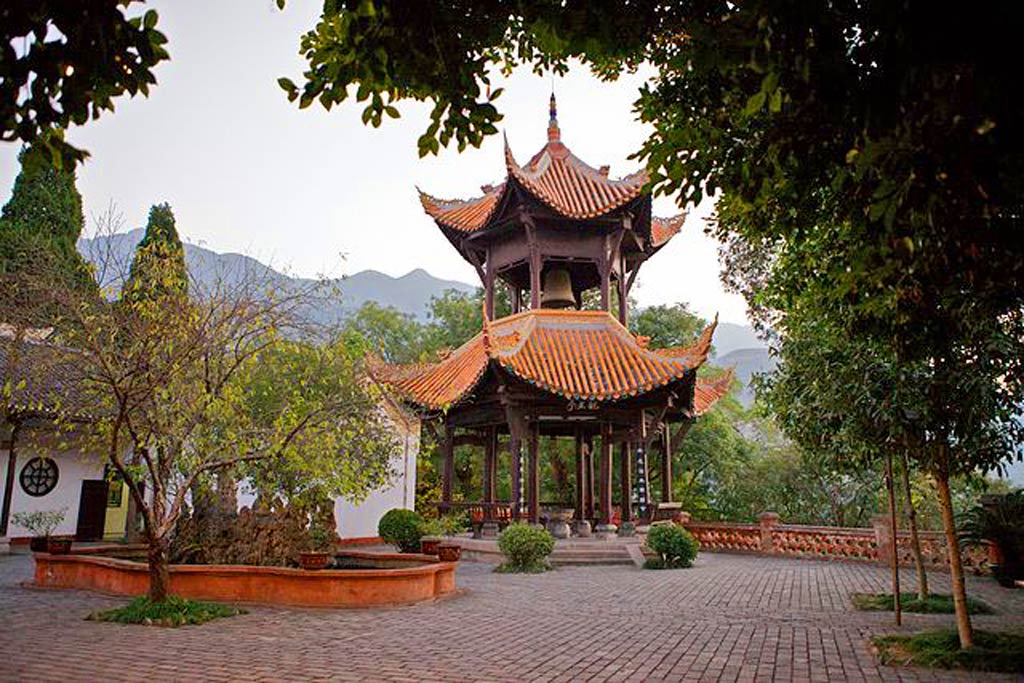
Fengdu: The "Ghost City" and Relocation Village
Located 176 kilometers downstream from Chongqing, the plethora of fascinating demon-decorated temples and statues on Mingshan Hill, vividly depicting the Chinese people’s imagination of Hell, earned it the moniker “Ghost City”.
Two officials from the imperial court–Wang Fang Ping and Ying Chang Sheng were bored with political life in the court and came to Mt. Minshan outside Fengdu city to practice Taoist teachings. Both of them later became immortals by carrying out self-cultivation. When combined together, their surnames Yin and Wang sound very much like “King of Hell” in Chinese. Hence the people began to call Fengdu the “Ghost City”.
Opposite Mingshan Hill on the Yangtze’s south bank can be seen the new relocation village built for families who moved as a result of the Yangtze’s rising waters, brought about by the Three Gorges Dam.

Jade Emperor Scenic Area: A supreme deity in Taosim
The scenic area of the Jade Emperor is located on the north bank of the Yangtze near Fengdu. The area encompasses more than 40,000 square meters, and includes 30 different styles of traditional architecture and 208 carved deity sculptures. The largest image of the Jade Emperor in the world is here.
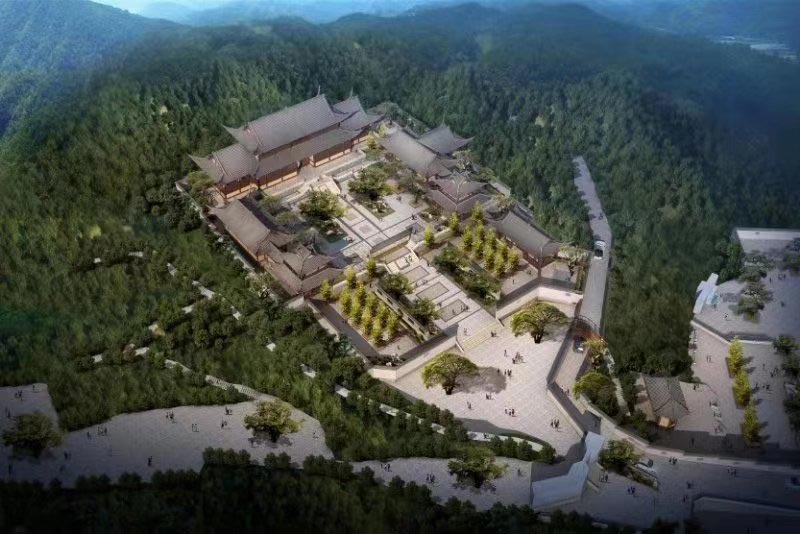
Xiaoguanshan Park & Mt. Shuanggui: An area known for its beautiful scenery and cultural relics
Xiaoguanshan Ancient Folk Culture Park near Fengdu is a noted site for the relocation and reconstruction of architectural and cultural relics, after the water level rose on the Yangtze as a result of the Three Gorges Dam project. The park reproduces historic ancient residential buildings, courtyards, temples, wood carvings and city gates in the Fengdu region, providing a deep sense of its history and ancient way of life. Performances here include Sichuan opera, acrobatics, folk music, and puppet shows.
Mount Shuanggui faces the Yangtze River, and is a national forest park known for its picturesque scenery, which integrates history, culture and modern art. Mt. Shuanggui has for centuries been a favorite destination for literati and artists. There are cliff brush writings of calligraphists here from the Song Dynasty to the present day, and pavilions are named for notable historic figures.
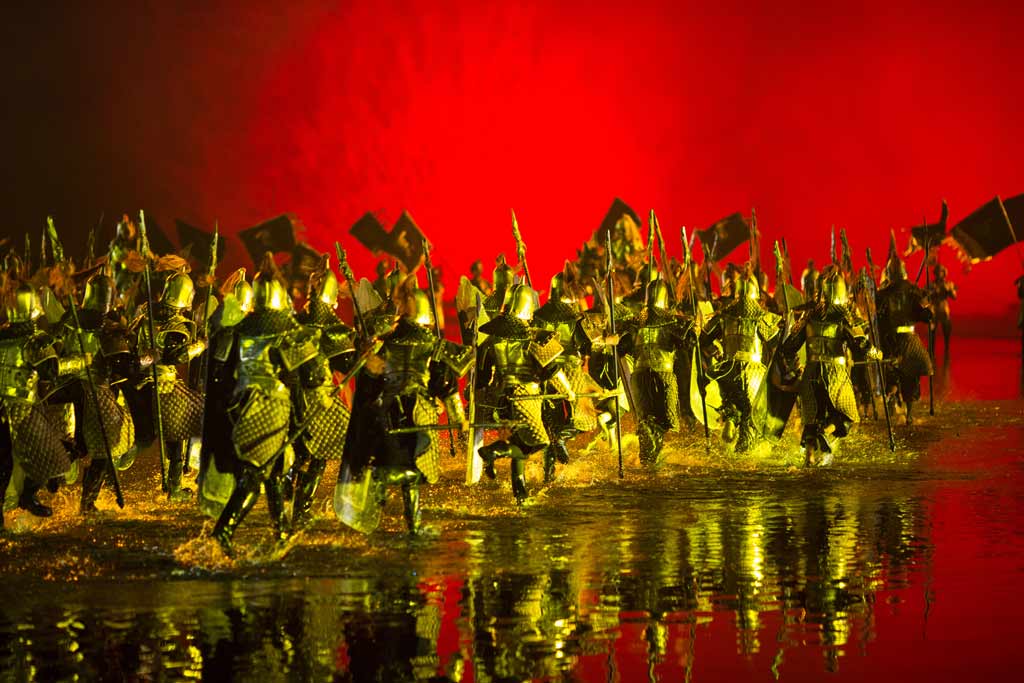
Romance of The Three Kingdoms: Fengyan Sanguo (Zhonxian County)
On downstream cruises, this additional optional excursion offers an elaborate evening show about the history and culture of the Three Kingdoms Period. Vivid scenes include songs, dances, acrobatics, sound effects and 3D holographic laser projection.
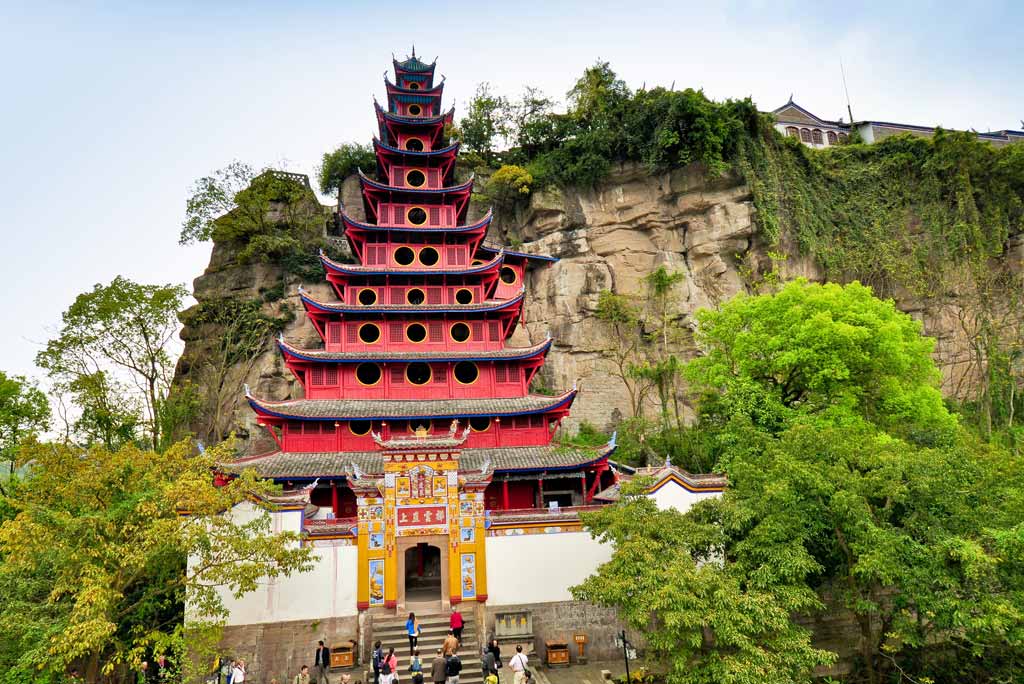
Shibaozhai: "The Pearl of the Yangtze"
Shibaozhai represents one of the gems of Chinese architecture along the Yangtze River. From afar, the protruding 220-meter (720 foot) hill on the north bank appears to resemble a jade seal. The creation of the hill is attributed to the goddess Nuwo, who caused a rockslide while she was redecorating the sky after a fierce battle between two warring dukes. A red pavilion hugs one side of this rock. Its tall yellow entrance gate is decorated with lions and dragons. The temple at the top was built during the reign of the Emperor Qianlong (1736-96). In 1956, three more stories were added. The rising waters of the river as a result of the Three Gorges Dam have surrounded the pagoda, which is preserved with a tiny dam of its own. No nails were used in the construction of this magnificent structure.

Return To The Three Gorges Show: Fengjie — an imaginative epic tale
In 2019, Victoria Cruise Lines introduced the acclaimed live-action performance and hi-tech spectacle “Return to the Three Gorges” performance as an optional excursion on upstream cruises. Directed by world-renowned director Zhang Yimou, this epic tale focuses on landscapes and the environment. It elaborately depicts scenes from Chinese poems with imaginative choreography and hi-tech projections on a river stage near Qutang Gorge.
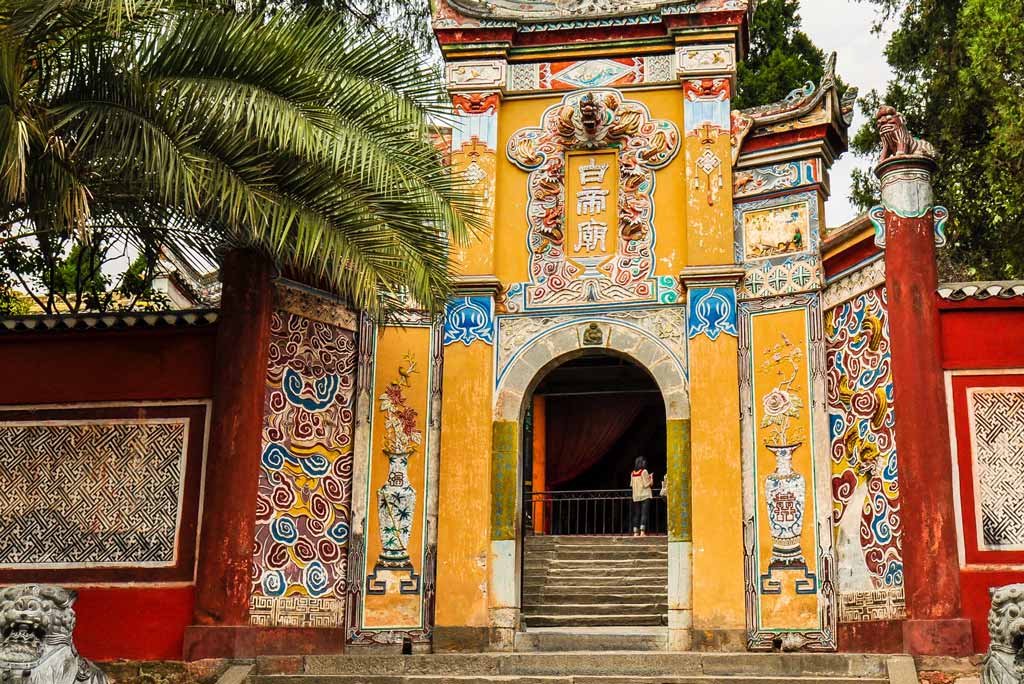
White Emperor City: An ancient city at the entrance to Qutang Gorge
White Emperor City overlooks the western end of Qutang Gorge. It has long been a refuge for would-be kings and poets, who have traveled here to be inspired by the majestic views of Qutang Gorge.
The great poet Du Fu is believed to have written numerous poems at the Western Pavilion on the mountain slope overlooking the Yangtze.
Legend has it that in 25AD, white vapor in the shape of a dragon rose from a well here, and Gong Sunshu, a soldier who had his headquarters here declared himself the White Emperor.
Remains of the city wall can be seen on the hill behind Baidi Mountain, and a temple built to commemorate Gong’s reign dates back over 1,950 years.
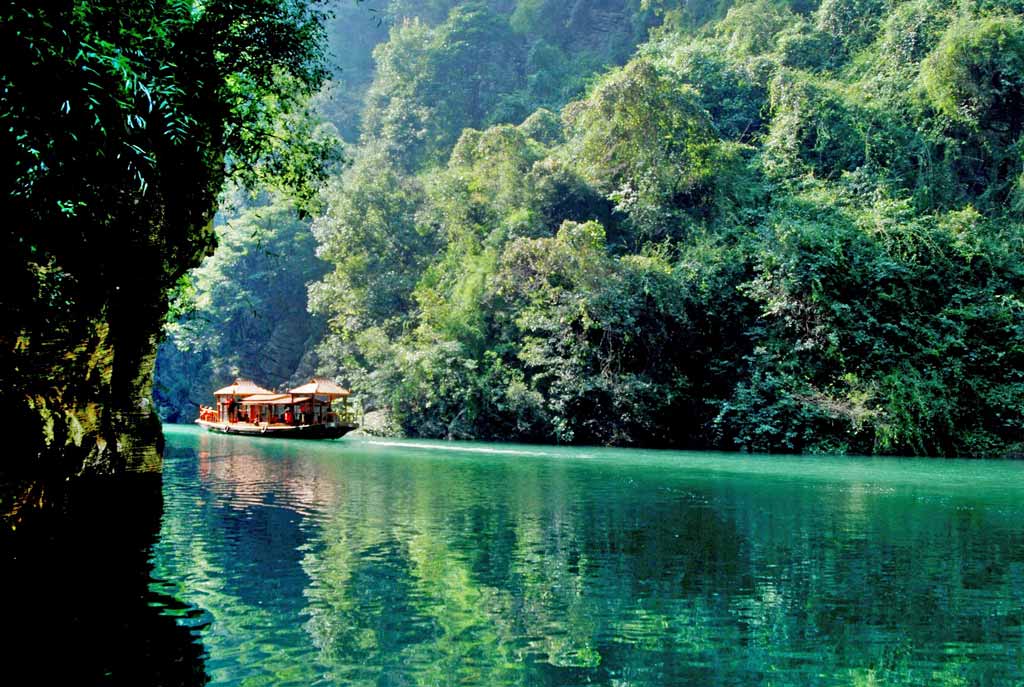
Goddess Stream: "Shennv Xi"
Goddess Stream flows from the southern bank of the Yangtze opposite Goddess Peak. Passengers board a smaller craft for a ride of about 15 kms. each way, to view the beauty of its narrow gorges. They will enjoy local folk songs and dances along the way. Once just a brook, the Three Gorges Dam raised the water level to 70-100 meters in depth, depending on the season. Surrounded by beautiful peaks, many protected species live here, including monkeys, mountain goats, deer and boar, as well as varieties of Chinese medicinal herbs. The area is also famous for its tea, named “Longevity Tea” or “Mountain Tea”. Agriculture is the major occupation of people living in the region; they grow three crops a year, including corn, potato, sesame, pepper, oranges, peaches, pears, and bananas, as well as varieties of Chinese medicinal herbs.
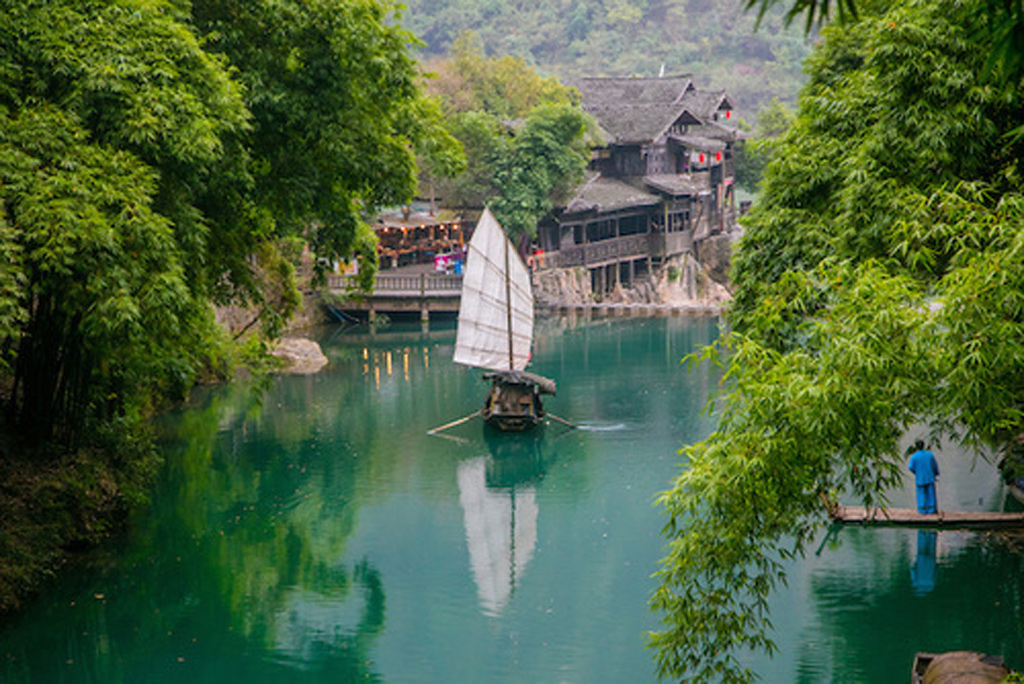
Shennong Stream: Named for the mythical founder of Chinese medicine
Board a ferry boat for a relaxing ride up this tributary of the Yangtze, which has its own attractive gorges. This wild preserve is home to more than 1,000 types of trees, and is named for the legendary peasant and mythical founder of Chinese medicine, Shennong, who hiked the cliffs and collected herbs here.
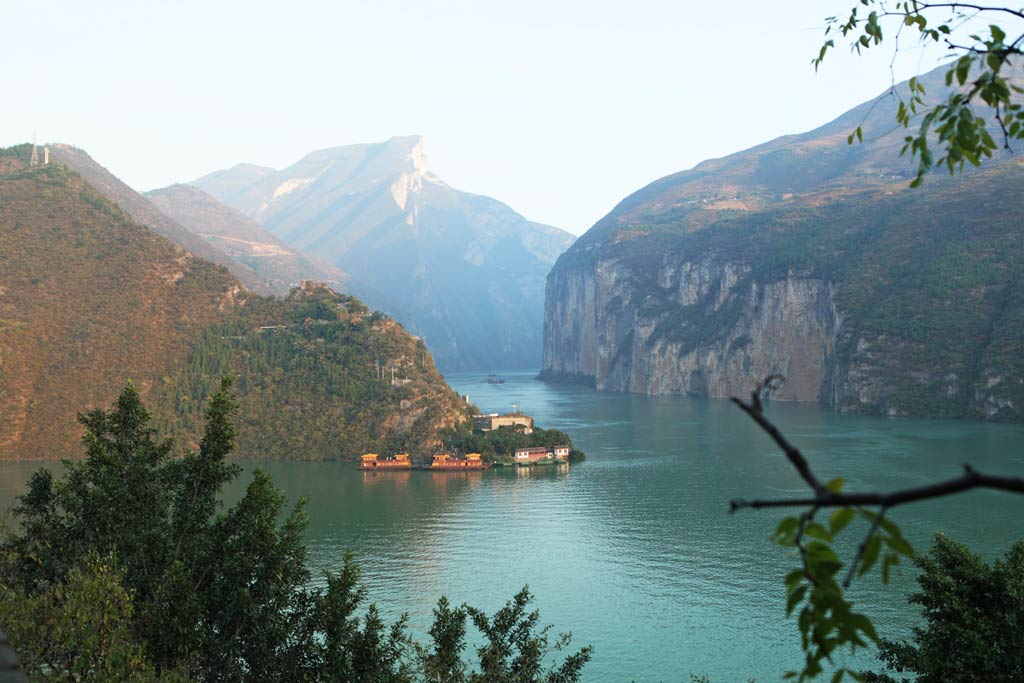
Three Gorges: One of nature’s most extraordinary sculptures, the Three Gorges run from Fengjie in the west to Yichang in the east.
QUTANG GORGE
The first of these masterpieces, Qutang Gorge is the shortest (5 miles), narrowest (500 feet), and most dramatic. Two mountains, Red Passage Mountain and White Salt Mountain, guard the entrance like giant castle doors.
WU GORGE
Below Wushan is the 25-mile long Wu or Witches Gorge, with cliffs so sheer that the sun barely penetrates the precipices. It is best known for twelve unique peaks. Often hidden in swirls of mist, six line the north side of the river and six to the south. The most famous, Goddess Peak, resembles a kneeling maiden.
XILING GORGE
The longest (41 miles) and the deepest, Xiling is comprised of seven smaller gorges, whose names — Military Books and Precious Sword, Rice Granary, Ox Liver and Horse Lungs, Yellow Ox, Bright Moon, Lantern Shadow, and Yellow Cat—are based on ancient legends.
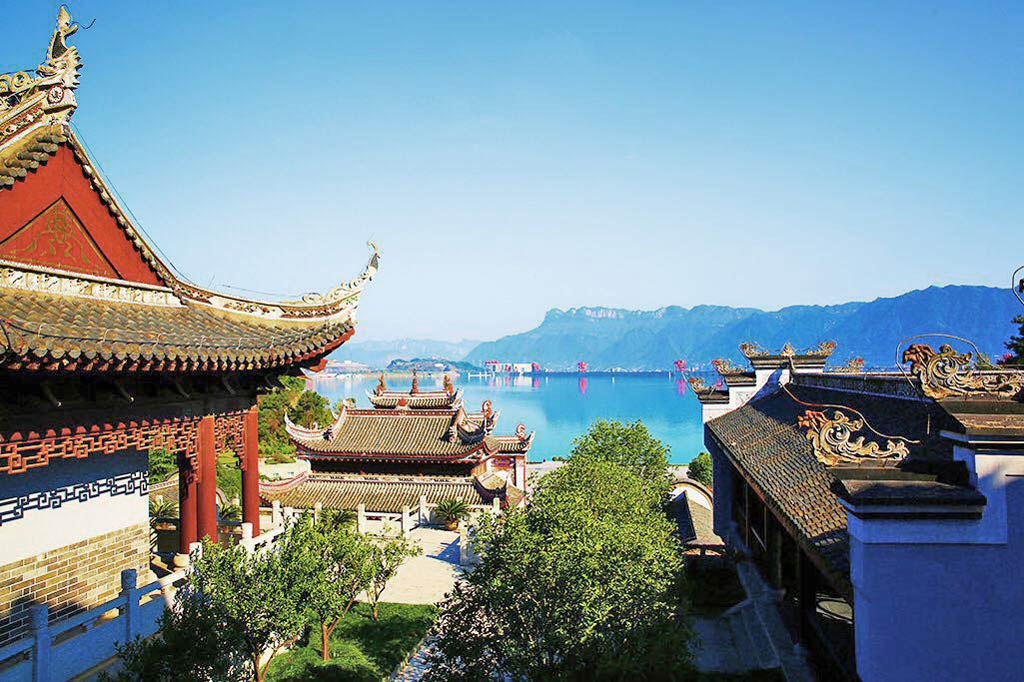
Zigui, Hometown of Qu Yuan: A great poet and statesman
At the foot of Phoenix Mountain in Zigui County (Hubei Province) is the hometown of Qu Yuan (340-278 BC), a cultural scenic spot which includes an expansive view of Three Gorges Dam Project and surrounding scenery. This scenic spot was first built in 850 AD, and after a several refurbishments and enlargements, it is now considered one of top 30 new touring sites along the Yangtze.
Qu Yuan was known as a great patriot poet and statesman, who served as a chancellor to King Huai of the Kingdom of Chu. His political enemies had him exiled, and in despair, he drowned himself in Dongting Lake. Historical records indicate that the local people searched for his body in Dongting Lake, while beating drums and racing their boats. This event was the origin of the Dragon Boat Festival, which is commemorated each May.
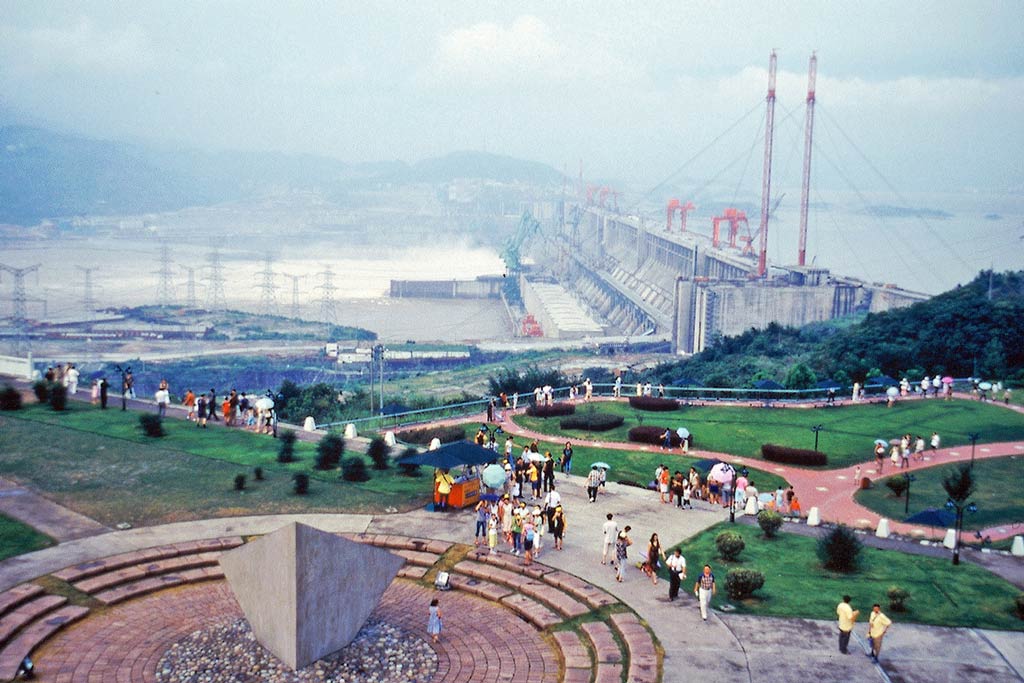
Three Gorges Dam
Begun in 1994 and completed in 2009, the Three Gorges Dam is the largest water conservancy project ever undertaken by man. The Dam is located near Sandouping, which is in the middle of the Xiling Gorge, the longest of the Three Gorges.
The Three Gorges Dam is 2,335 meters long, 185 meters high, 18 meters wide on the top and 130 meters wide at the bottom. The dam has raised the river to a level of 175 meters above sea level, creating a 600 kilometers long reservoir with storage capacity of 39.9 billion cubic meters extending from the dam site all the way to Chongqing. 570,000 acres of farmland, villages, and cities in 19 counties have been flooded, causing 1.5 million people to be relocated.
The estimate for construction of the project is 26 billion US dollars. The building of this huge dam was for the purpose of flood control, electricity, navigation, and irrigation.
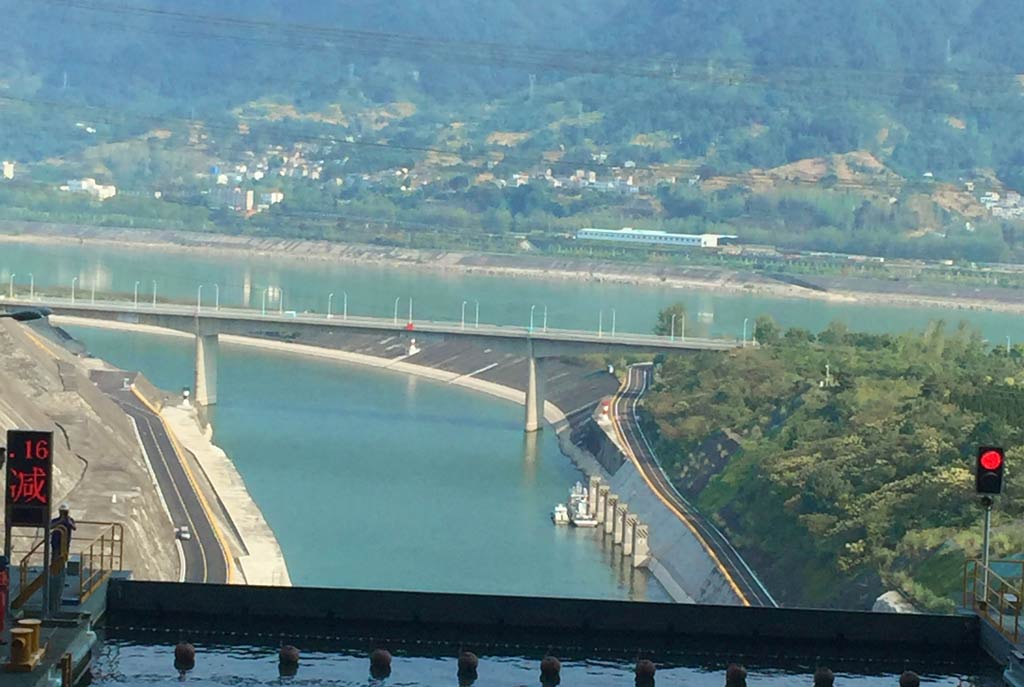
Ship Lift, Sandouping: The world's largest ship lift
In 2017, Victoria became the first cruise line to use the new ship lock equipped with a ship lift at the Three Gorges Dam. The other 5-stage ship lock at the dam is utilized primarily for cargo ships, and takes 3 to 5 hours to traverse. The new ship lock lift, designed for passenger ships (with safety features for passenger ships, including a fire escape), can be transited in 40 minutes to an hour. An optional excursion through the ship lift is now available to passengers aboard Victoria.
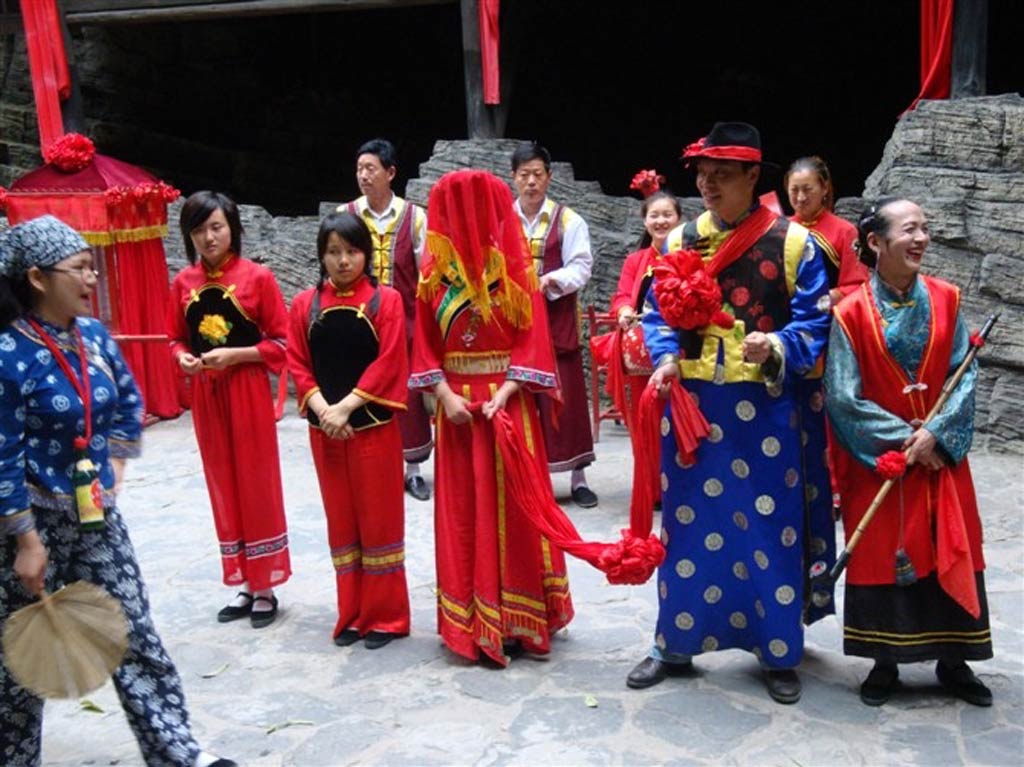
Tribe of The Three Gorges: An interesting glimpse into local life in the Xiling Gorge Region
This additional optional shore excursion is offered on upstream cruises from Yichang to Chongqing. Visit Toad Spring, statues of the ancient Ba Nationality, Scenic Dragon Stream, a boatman performance, local fishermen, Monkey Hill (there are more than 200 wild monkeys here), “Lower Bridge”, Huanglong Waterfall (“Waterfall of Man”) and “Crying Wedding Performance” (a custom of the Tujia nationality).
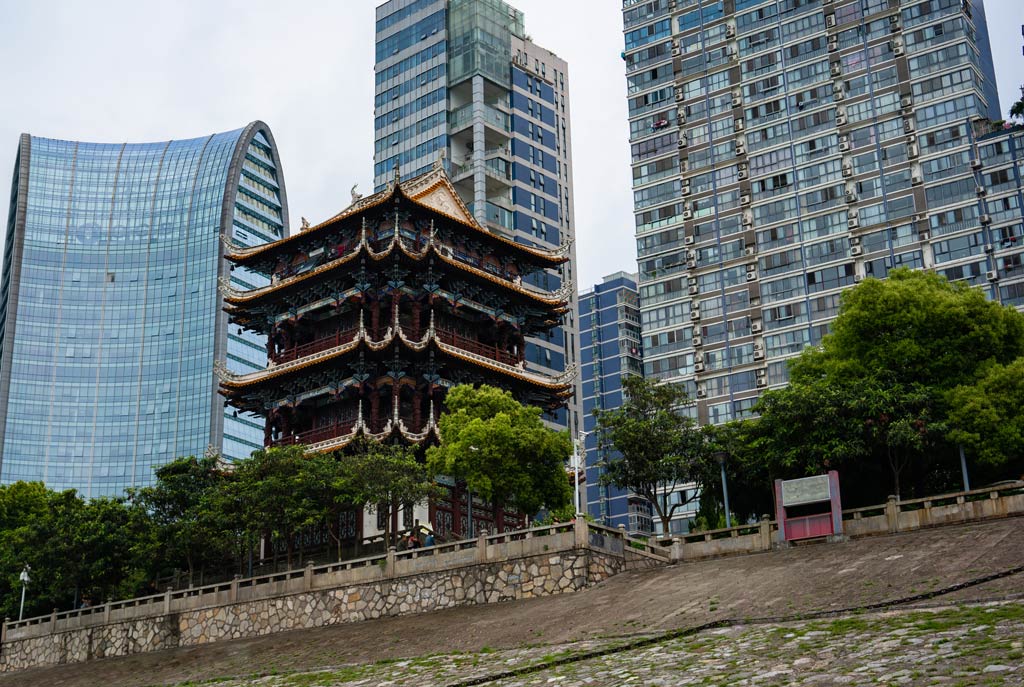
Yichang: Economic and cultural center of western Hubei Province
Situated at the entrance to Xilng Gorge, the construction of the Gezhouba (Gezhou Dam) changed this sleepy first-century town into a thriving metropolis. Just six miles northwest of the city is awe-inspiring Three Travellers Cave. Here, both Tang-dynasty and Song-dynasty poets inscribed poems on the cave’s walls. Throughout the ages, other visiting literati have offered their own contributions.
